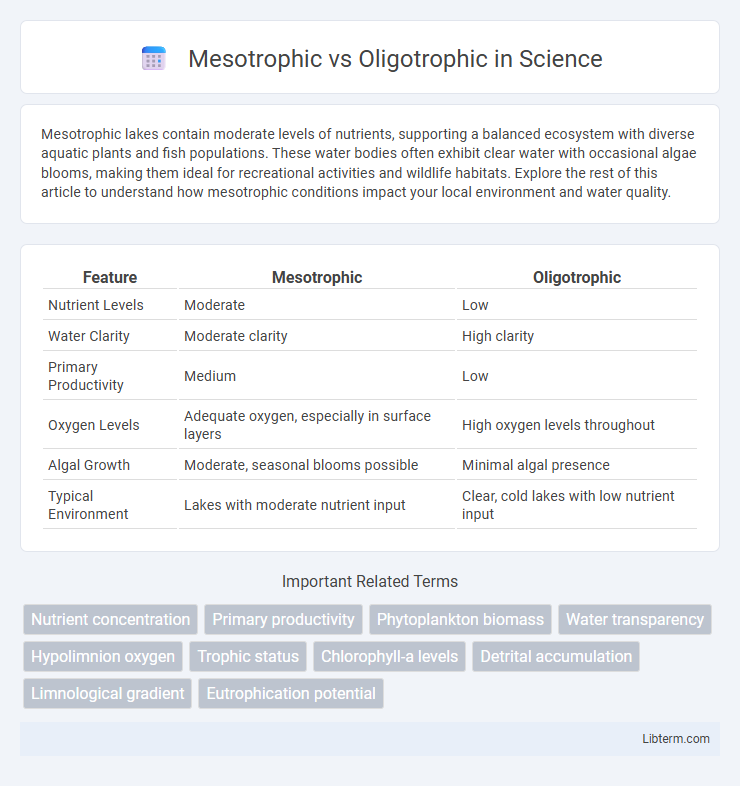Mesotrophic lakes contain moderate levels of nutrients, supporting a balanced ecosystem with diverse aquatic plants and fish populations. These water bodies often exhibit clear water with occasional algae blooms, making them ideal for recreational activities and wildlife habitats. Explore the rest of this article to understand how mesotrophic conditions impact your local environment and water quality.
Table of Comparison
| Feature | Mesotrophic | Oligotrophic |
|---|---|---|
| Nutrient Levels | Moderate | Low |
| Water Clarity | Moderate clarity | High clarity |
| Primary Productivity | Medium | Low |
| Oxygen Levels | Adequate oxygen, especially in surface layers | High oxygen levels throughout |
| Algal Growth | Moderate, seasonal blooms possible | Minimal algal presence |
| Typical Environment | Lakes with moderate nutrient input | Clear, cold lakes with low nutrient input |
Introduction to Mesotrophic and Oligotrophic Waters
Mesotrophic waters exhibit moderate nutrient levels with balanced productivity supporting diverse aquatic life, often found in lakes with intermediate stages of ecological succession. Oligotrophic waters are characterized by low nutrient concentrations, resulting in clear water and minimal primary productivity, typically associated with deep, oxygen-rich lakes. Both types are crucial for understanding aquatic ecosystems and managing water quality in freshwater environments.
Defining Mesotrophic and Oligotrophic Ecosystems
Mesotrophic ecosystems feature moderate nutrient levels, supporting balanced aquatic plant and animal growth without excessive algae blooms. Oligotrophic ecosystems possess low nutrient concentrations, characterized by clear waters, high oxygen content, and limited productivity. These distinctions influence biodiversity, water quality, and ecological functions within lakes and freshwater environments.
Key Differences in Nutrient Levels
Mesotrophic lakes have moderate nutrient levels, supporting balanced aquatic plant and algae growth, while oligotrophic lakes exhibit low nutrient concentrations, resulting in clear water with minimal productivity. The higher nutrient availability in mesotrophic environments promotes increased biological activity and biodiversity compared to the nutrient-poor and oxygen-rich conditions of oligotrophic lakes. These differences significantly impact ecological dynamics, water quality, and suitability for various aquatic species.
Biological Productivity Comparison
Mesotrophic lakes exhibit moderate biological productivity characterized by balanced nutrient levels that support diverse aquatic plant and animal life. Oligotrophic lakes have low nutrient concentrations, resulting in limited primary productivity and clearer waters with less organic matter. The difference in nutrient availability directly influences the biomass and species diversity in these freshwater ecosystems.
Water Clarity and Transparency
Mesotrophic lakes exhibit moderate water clarity and transparency due to balanced nutrient levels supporting moderate algal growth, typically ranging from 2 to 4 meters of Secchi disk depth. Oligotrophic lakes have high water clarity and transparency, often exceeding 4 meters on the Secchi disk, resulting from low nutrient concentrations and minimal algal populations. These differences in water clarity directly impact aquatic ecosystems, influencing light penetration and habitat conditions for fish and other organisms.
Flora and Fauna Diversity
Mesotrophic lakes exhibit moderate nutrient levels that support a balanced diversity of flora and fauna, including abundant aquatic plants, algae, and a variety of fish species such as bass and bluegill. Oligotrophic lakes have low nutrient concentrations, resulting in sparse aquatic vegetation and low primary productivity but are home to cold-water fish species like trout and whitefish adapted to clear, oxygen-rich waters. The contrast in nutrient availability between mesotrophic and oligotrophic lakes directly influences the richness and composition of their respective ecosystems.
Geographic Distribution and Examples
Mesotrophic lakes, characterized by moderate nutrient levels, are commonly found in temperate regions such as the Great Lakes in North America and Lake Balaton in Hungary, supporting diverse aquatic ecosystems. Oligotrophic lakes, with low nutrient concentrations and high oxygen levels, are typically located in mountainous or northern areas including Lake Tahoe in the United States and Loch Ness in Scotland, known for clear waters and limited biological productivity. Geographic distribution reflects nutrient availability and geological factors, influencing trophic states and aquatic biodiversity in these water bodies.
Environmental Implications and Human Impact
Mesotrophic lakes, characterized by moderate nutrient levels and balanced aquatic ecosystems, are more vulnerable to nutrient pollution and algal blooms due to surrounding agricultural runoff and urbanization. In contrast, oligotrophic lakes, with low nutrient concentrations and high oxygen levels, support diverse, sensitive species but are highly susceptible to acidification and contamination from industrial pollutants. Both lake types play crucial roles in maintaining regional biodiversity and water quality, with human activities directly influencing their ecological health and sustainability.
Water Quality Indicators and Monitoring
Mesotrophic lakes exhibit moderate nutrient levels and biological productivity, reflected in intermediate concentrations of chlorophyll-a, total phosphorus, and dissolved oxygen, making these key indicators for water quality monitoring. Oligotrophic lakes display low nutrient content and high oxygen levels throughout, often monitored through parameters like low chlorophyll-a, ultra-clear water transparency, and minimal total phosphorus concentrations. Regular assessment of these water quality indicators enables effective differentiation between mesotrophic and oligotrophic conditions, guiding ecosystem management and pollution control efforts.
Management Strategies and Conservation Approaches
Mesotrophic lakes require balanced nutrient management to prevent shifts toward eutrophic conditions, emphasizing controlled agricultural runoff and moderate phosphorus inputs. Oligotrophic lakes demand stringent protection from nutrient enrichment through conservation approaches such as buffer zones, limited development, and strict pollution regulation. Both ecosystems benefit from continuous water quality monitoring and habitat restoration to maintain ecological integrity and biodiversity.
Mesotrophic Infographic

 libterm.com
libterm.com